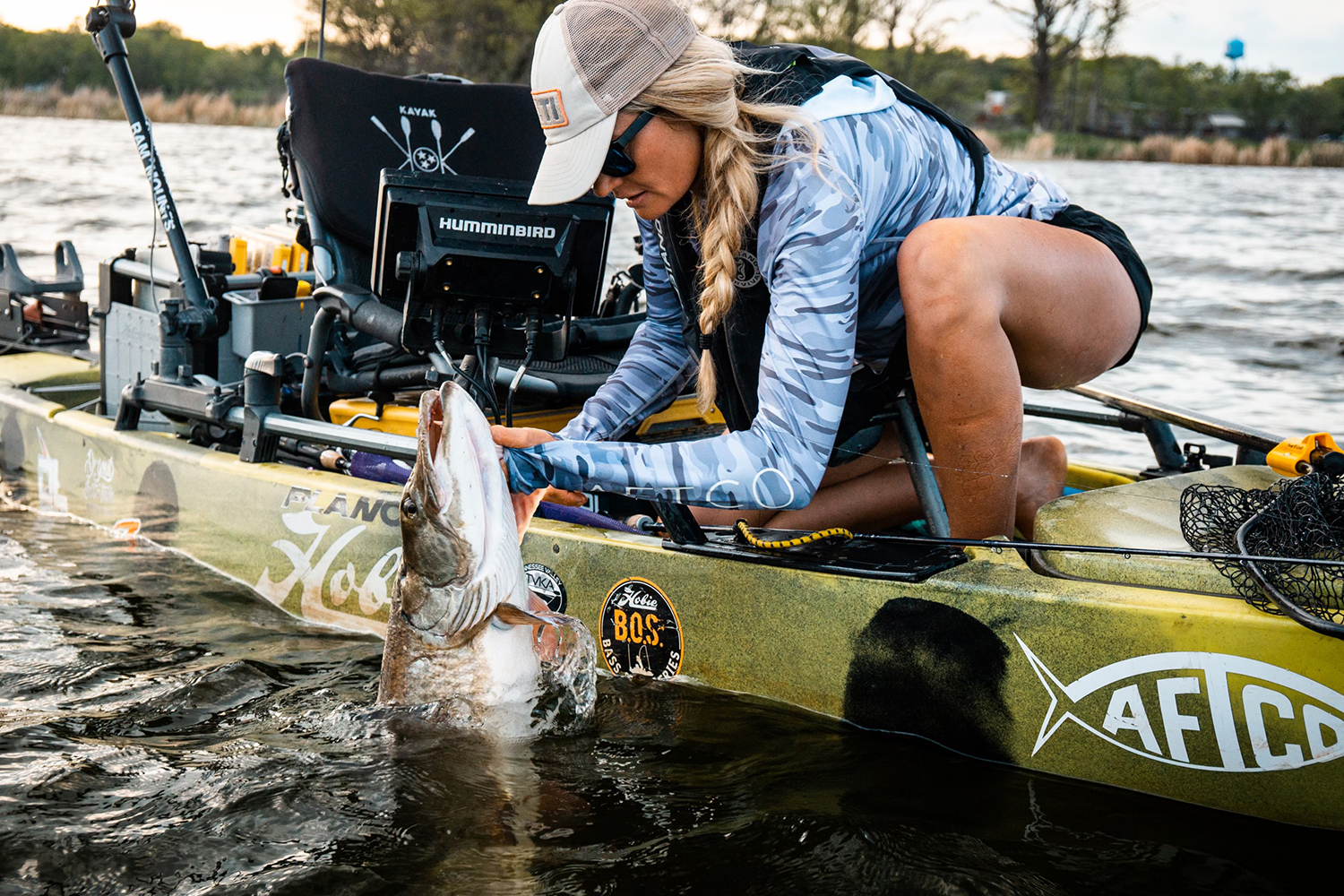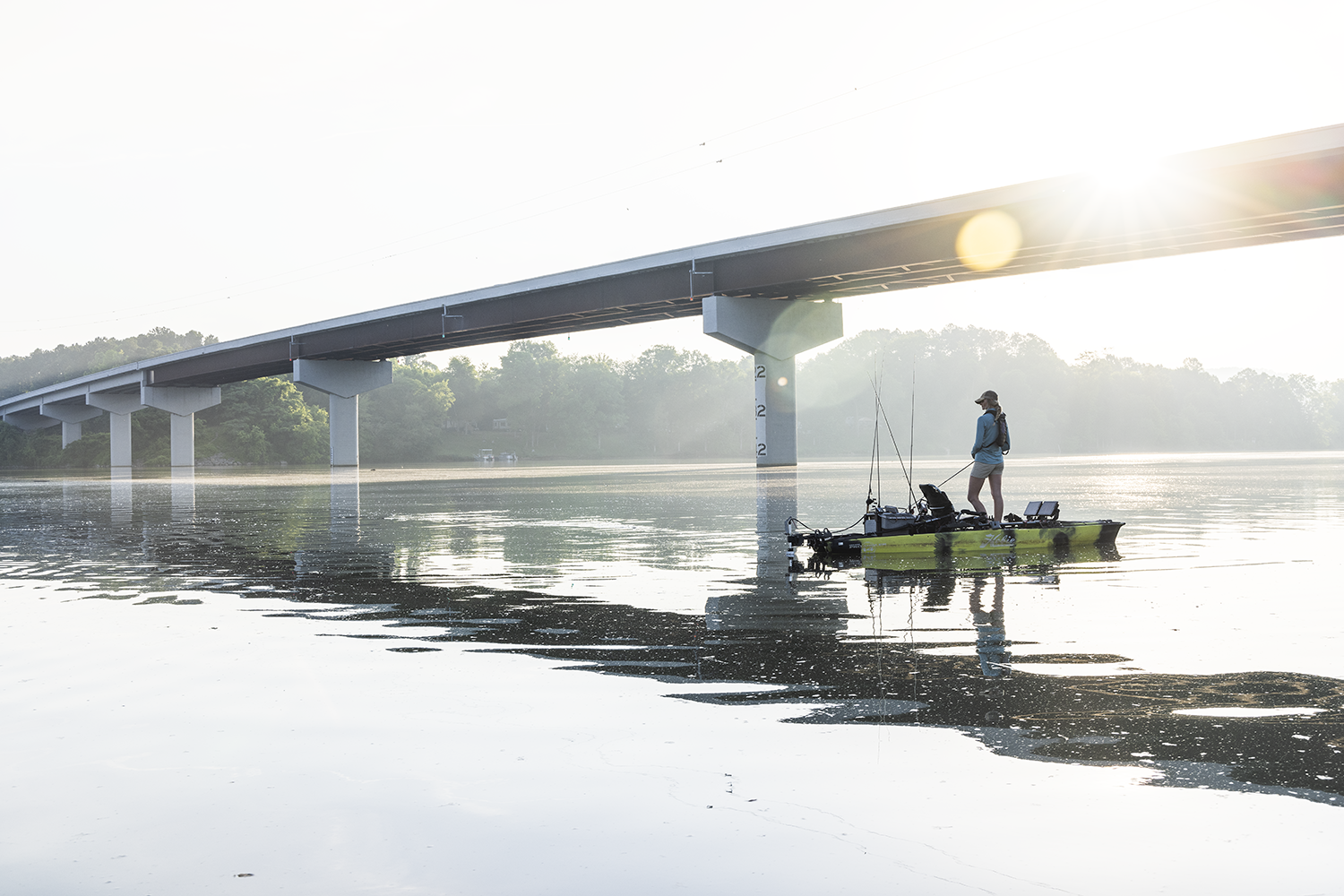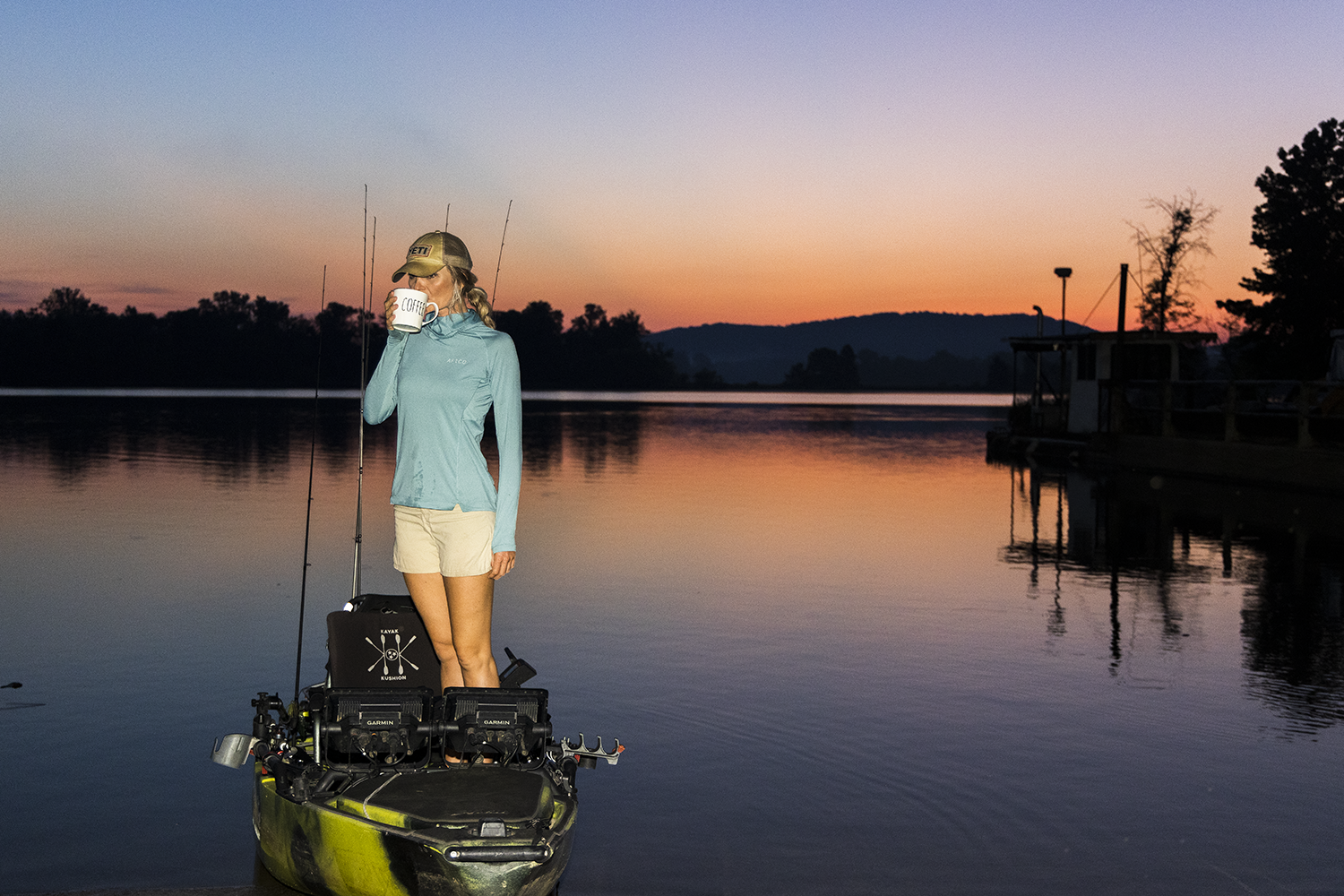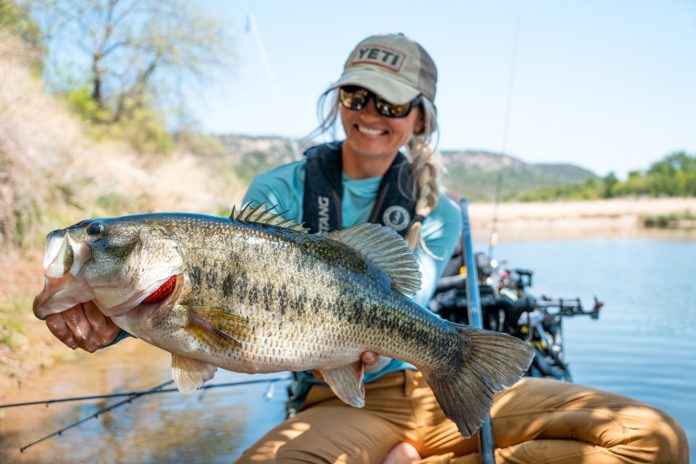IT’S A MUGGY February day in south Florida, and pro kayak angler Kristine Fischer is on the water, fishing during a break between tournament stops. She’s hunting big bass, casting a Texas-rigged 4-inch creature bait and working it through thick hydrilla growing up from the lake’s bottom. Her sonar shows a sizable blip. Fischer casts to it and waits. She’s anticipating the feel of weightlessness, which means only one thing—a largemouth is gulping her bait. In an instant, Fischer rears back in the seat of her kayak to set the hook with so much force that if there were no back to the chair, she would tumble out of the kayak and into the water.
“Oh God, it’s a big one. That’s a giant. I can’t control it. OH MY GOOOOOOODDDDD!”
https://www.youtube.com/watch?v=/BCSkDrnqJqU
Fischer is known for her excited reactions when she hooks into a big fish (you can watch many of them on her Instagram or YouTube channel, which has almost 50,000 subscribers). And at this moment, she is full-on losing it as an 11-pound bass—her second of the day—takes line. It’s running through the weeds as Fischer leans from one side of the kayak to the other, fighting to land what will be her personal-best bass. The fish tapes out at 26 inches and weighs 11.8 pounds, ¼ inch longer and a few ounces heavier than the PB bass she caught using the same bait just hours ago.
Kayak fishing has become widely popular over the past decade, and 34-year-old Fischer has been one of its strongest ambassadors because she works to promote it. She writes about fishing and has a strong social media presence. Her GoPros are rolling while she fishes in tournaments, and later she’ll create videos that bring viewers along and reveal some of her secrets to catching bass.
Anyone with a phone and fishing rod can pull that off these days. But Fischer is genuinely talented: She’s one of the few women to ever win a major co-ed pro bass tournament. What makes her so refreshing is that she not only catches giant bass, she works her ass off to make it happen.
Rise of the Kayak Tourneys
“When I am fun fishing, it’s to practice different techniques and casts, but I am also looking for a big bite,” Fischer says. “When I’m on the lake with my friends, I want to catch giants. … For tournaments you have to practice, but it’s more like homework. When I pre-fish before a tournament, I am looking for places where I think bass will be, and maybe I will make a few casts. You’re not going out there to catch as many fish as you can on the first day, because you have to manage those fish and have something to catch as the tournament rolls on.”
Fischer got her start entering local tournaments in her home state of Nebraska and guiding kayak-fishing clients there for her friend Marty Hughes. Her obsession with catching bass expanded into regional tournaments and now the national trails. In just five years, Fischer has become one of the top tournament anglers in the sport. Last year she became the first woman to win the Hobie Bass Open Tournament of Champions, kayak fishing’s version of the Bassmaster Classic. Fischer beat out 50 of the best anglers in the world and cashed a $35,000 check.
Of course, that quick rise has led to corporate sponsorships and a slew of media requests. It’s a full schedule of photo shoots, appearances, and interviews—all time away from Fischer’s passion. But she continues to succeed on the pro trails despite the distractions.

“I think she has inspired a lot of people in kayak fishing,” says Hughes, who organized some of the first kayak-fishing tournaments in the Midwest more than a decade ago. “She is competitively driven to do well in whatever she does. If she had become a doctor, she would be one of the best doctors out there. If she had become a lawyer, she would be the best lawyer. But she chose this endeavor in the outdoors, and so she is the best at it. Kristine eats, drinks, and sleeps fishing.”
In the U.S., tournament kayak fishing—both saltwater and freshwater—still hasn’t reached its full potential. Men including Hughes, Marty Mood, Chad Hoover, and Jim Sammons are credited with starting the first regional kayak trails a decade ago. Today, there are three national trails: the Hobie Bass Open Series (BOS), Kayak Bass Fishing (KBF), and the Bassmaster Kayak Series (BASS). Tournaments begin in January and wrap up in November, taking place on many of the same lakes as the more well-known tours—Bassmaster and Major League Fishing.
Unlike those big bass tours, the beauty of this sport is that just about anyone with a kayak, tackle, and a few hundred bucks for the entry fee can participate in a tournament and fish head-to-head against the pros. There are stops on KBF that you must qualify for, and the Hobie TOC is reserved for the best anglers each year, but otherwise all are welcome. You may run into established pros from the big-boat tours, such as Mike Iaconelli and Jordan Lee, who are starting to dabble in kayak tournaments as well, further legitimizing the kayak trails.
During these multiday tournaments, anglers don’t bring their catch back to the dock in a live well. Once they land a bass, competitors simply snap a photo of it and submit the image to a tournament app. Bass are measured by length, not weight as in big-boat tournaments. This returns the fish to the water more quickly, which is better for the overall health of the fishery. Total length wins the event.

But if you’re thinking of making kayak fishing a career, just know that only about 20 anglers are winning enough money to fish full time. Open tournaments will pay as much as $10,500 to a winner, and the championship cash-outs are closer to $45,000. So there’s not a lot of money to go around, and you must consistently place in the top 10 or 15 in fields of 150 or more to survive. That tells you how accomplished an angler Fischer has become in the five years since she joined the trails.
“We were out there showing the world that there were women who fished, but deep down I think we all secretly hoped that a woman would enter the tournament fishing scene,” says April Vokey, a fly-fishing guide and host of the podcast Anchored. “We needed to show that it didn’t matter what your gender was, that you could be just as much a badass on the water as the guys. Kristine closed that circle. I feel like she was the final piece.”
Fischer grew up in the small mining town of Weeping Water. And most folks will tell you she is still the same person: a hardworking kid from a close-knit community in southeast Nebraska. Fellow kayak angler Jody Queen, who has won more than 30 tournaments, including the 2019 Hobie TOC, says Fischer’s success is rooted in that practical mindset.
“She is driven, but she’s grounded,” says Queen. “She had a goal and a plan and set out after it … and she is achieving it.”
For the most part, Fischer has been well received as the tournament circuit’s new favorite.
“In the beginning I overheard some guys saying that ‘she ain’t gonna last’ or ‘she is just a pretty face trying to sell a product,’” says Queen. “But that lasted only a very short time, because she started beating those guys, and after that, they didn’t have much to say about it.”
A Muskie Bum Becomes a Bass Fanatic
Nebraska isn’t a bass-fishing mecca. Fischer grew up obsessed with chasing pike and muskies. She and her younger brother never played video games. The family didn’t even own a television. Instead, the two spent most of their time outdoors, digging up fossils, playing in creekbottoms, and casting lines into small farm ponds and rivers. Fischer’s parents loved to travel, so they spent her childhood vacations fishing and camping in Minnesota’s Boundary Waters, Canada, the Dakotas, and Colorado. Even into her teens and early 20s, Fischer devoted herself to pike and muskies.
“I didn’t start focusing on bass fishing until I started competing,” says Fischer. “A lot of people don’t realize that I didn’t grow up with a flippin’ stick in my hand. I was chucking baits for pike and muskie.”

Fischer went to junior college in Kansas on a volleyball and academic scholarship, but the structure of practice and classroom time didn’t suit her. She left after just six months and eventually finished her degree online. All week she would fish and work two or three waitress and bartending jobs before cramming her assignments into a few hours on Sunday evenings and submitting them before the midnight deadlines.
At one of her waitressing gigs, a group of guys would come in from the sporting goods retailer Scheels to eat lunch. They would talk fishing and hunting with Fischer, and she eventually took a job as a manager at Scheels. While she was stringing a customer’s compound one day, someone handed her a flier for a local kayak-fishing tournament. Intrigued, Fischer hopped online and bought an $800 kayak from Hughes, found a milk crate to store all her gear on the boat, and borrowed a life jacket.
When Fischer arrived at the parking lot of the boat ramp the next morning, a group of 45 men were milling around, waiting for the day to begin. She had the kayak strapped to the top of her car and nervously struggled to get it down while they all stared at her. A few of the men offered to help, but Fischer refused. “I got it,” she told them. Fischer went on to finish third, and the hook was set.
The Early Trails
That initial tournament was in the fall, when Fischer was in her late 20s. Over the next year, she competed in a local grassroots club circuit.
“I wanted to show everyone that I could fish, because it was so male-dominated and I always felt like I had to prove myself,” Fischer says. “Then I fell in love with [kayak fishing]. I started to get to know some of the guys, and Marty [Hughes] took me under his wing.”
Fischer performed well enough on the club circuit to secure an invitation to a national-level tourney on Lake Fork in Texas. She went South with loads of confidence but left wondering if there was a future for her in kayak fishing at all.
The field was stout, full of pro anglers who “kicked my butt,” says Fischer. She hadn’t caught a single fish. On the drive home, she considered giving up and keeping her job as a Pilates instructor. The pros on Lake Fork took kayak fishing to a new level, and Fischer wasn’t sure she could keep up.

But Fischer doesn’t quit. She had hustled through college, paid her own tuition, and made enough money to eventually buy a home. She’d worked in a bow shop where no other woman had before, and she had beaten 40-odd men in her first-ever tournament, many of whom thought she wouldn’t even be able to unload her kayak. One poor performance wasn’t going to stop her.
Instead, she doubled down. Fischer started competing in regional tournaments and traveling out of state to fish for paychecks. She decided that no one would prepare better than she would and made it a point to be the first boat on the water and the last one off. Fischer dug into the history of the tournament lakes and scoured Google Maps for structure and points where she thought fish would be.
She had some success in the Midwest series and then branched out to the KBF trails.
“I was teaching Pilates and kept taking more and more time off work to fish,” Fischer says. “It was getting to a point where I needed to make a decision.”
In the throes of this deliberation, Fischer’s long-term relationship ended in a tough breakup. Her ex had been her traveling companion, familiar with tourney stops and a gateway to the tournament community. Now she would have to navigate it on her own. It was a difficult time in her life, and she was faced with two options: play it safe and go back to Nebraska or roll the dice and hit the road to fish full time. Fischer sold most of her belongings, rented out her house, and chased her dream.

It didn’t come easy. Fischer felt slightly lost those first two years. In all her previous jobs, she had been able to help others, whether it was by stringing a bow, serving a hot meal, or helping Pilates clients realize their fitness goals. Fishing didn’t initially fill that void.
“I know it was hard for her, and lonely, especially when you don’t know anybody,” says Rachel Barth, her college roommate and longtime friend. “I think there were some hard lessons, and maybe there were some people who were her ‘friends’ that she thought she could trust but found out later that she couldn’t. But that can happen in any life. You think you know somebody, and it turns out they are not as authentic as you thought they were. And she was facing this stuff on her own. That’s never easy.”
Social media was also portraying many female anglers in a less-than-ideal light. Images of bikini-clad women holding up giant fish they hadn’t caught became all too common on platforms like Facebook and Instagram. Fischer didn’t want to be lumped in with that crowd.
Fischer is tall, blond, and attractive, and she feared that people would think she was just fishing for likes. Instead, she wanted to be known for her skill as a fisherman—nothing more.
Finding Balance on the Water
For Fischer, the challenges of those first two seasons on the trails have evolved in the last three years into tournament success, new friendships, and just being on the water. It took a while, but all that time outside returned Fischer to her comfort zone, just like when she was a kid digging for fossils back in Weeping Water. Quiet mornings on the lake, pedaling her kayak into the lily pads, and the bite of a big bass all made Fischer whole again.
That led to more top-10 finishes and tournament wins. She’s qualified twice for Hobie Fishing Worlds, the most prestigious tournament in kayak fishing. And the realization of how much she needed kayak fishing drove her obsession to catch big bass. Without hesitation, she admits that the extended periods she spends on the water have pushed almost everything else to the wayside. But that’s the price you pay to be one of the best in the world, and Fischer has no regrets.

“Predicting what fish are going to do is what drives me,” Fischer says. “You don’t know what they are always going to do because Mother Nature is in control, and I get motivated by that challenge. You can’t ever truly predict or master it. It’s a science; it’s putting the puzzle pieces together. That’s what truly started my obsession, figuring out everything.”
Being obsessed with catching bass has also heightened Fischer’s ability to read conditions and put more fish in the boat. She wants to learn all she can about the habits of bass, and that inquisitiveness has taken her far. Anyone who has followed kayak fishing has seen her progression from an unknown to one of the best anglers in the sport. Hughes and Queen both referred to their friend as a sponge, saying Fischer soaked up every bit of knowledge they shared.
While fishing Guntersville Lake in Alabama this spring, Fischer dealt with changing conditions as the fish transitioned from spawning to post-spawn mode. She had to change her tactics accordingly to dial in the bite.

“I knew that if the main river was pulling current, the fish would be moving to the main-lake grass and feeding like crazy,” Fischer says. “It’s a current-driven bite, and if you don’t know that, you’re not going to catch as many fish. There are all kinds of small details like that you need to know if you’re going to win at this level.”
In her fifth year on the trails, Fischer has finally settled in. She’s dating another kayak angler and has fallen in with a close group of trusted friends—she travels with the same group of about 10 anglers to each stop. Fischer remains on the road almost year-round, driving a cluttered Nissan pickup full of plastic Plano bait organizers from one end of the country to the other. After years of crashing on couches, Fischer is finally building a home—though she will mostly use it as a rental—close to three of her favorite muskie holes. She is, after all, still a muskie bum at heart.
“I don’t look at myself as being this big figure in the sport, and probably never will, to be totally honest,” Fischer says. “But in terms of making a decent living fishing, sometimes I do sit back and kick my feet up and think, ‘My goodness, I did it.’”
This story originally ran in the Diehards issue of Outdoor Life. Read more OL+ stories.
How to Listen to Season 3 of the Outdoor Life Podcast
- Listen to Season 3, available now, on Spotify, Apple, or wherever else you listen to your podcasts. Seasons 1 and 2 are also available.
- Tune in every Wednesday for new episodes of Season 3.
Credit: Source link































